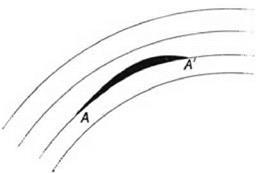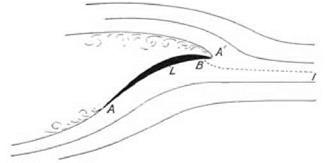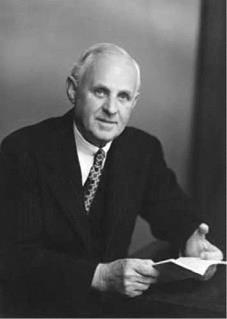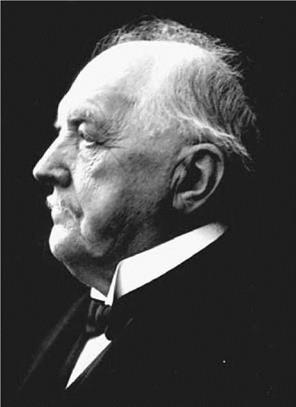A Firm Basis in Physics
Further objections to the circulation theory came from G. I. Taylor, one of Cambridge’s most brilliant young applied mathematicians. I have already mentioned his Adams Prize essay of 1914.60 In that work Taylor did not confine himself to rejecting discontinuity theory; he also rejected the circulatory account of lift. Critical of the unreality of the textbook hydrodynamics that Bryan so admired, he argued that “the important thing in the earliest stages of a new theory in applied mathematics is to establish a firm basis in physics” (preface, 5). After describing the central idea of Rayleigh-Kirchhoff flow and pointing out its empirical shortcomings, Taylor turned briefly to Lanchester’s theory. This too was faulted because of its lack of a firm basis in physics. Taylor’s dismissal of Lanchester was swift: “Besides these [discontinuity] theories of the resistance of solids moving through fluids, Mr Lanchester has proposed the theory that a solid moving through a fluid is surrounded by an
irrotational motion with circulation. This theory, as far as I can see, has nothing to recommend it, beyond the mere fact that it does give an expression for the reaction between the fluid and the solid” (4-5).
All that was granted to the theory, in its two-dimensional form, was that it had the (minimal) virtue of avoiding d’Alembert’s paradox. It permitted the researcher to deduce “an expression” for the resultant force on the body, but that is all. The formula, however, was not, in Taylor’s opinion, grounded in a real physical process. The theory provided no understanding of the mechanism by which the circulation round the body could be created. The problem came from Kelvin’s proof that circulation can neither be created nor destroyed. If Lanchester’s theory was an exercise in perfect fluid theory, then the premises of the theory precluded the creation of the very circulation on which it depended. Setting a material body in motion in a stationary fluid would not create such a flow. An aircraft, starting from rest on the ground in still air, and moving with increasing speed along the runway, would never generate the lift necessary to get into the air (not, at least, if the air was modeled as an ideal fluid). This consequence put Lanchester’s theory in no less an embarrassing position than discontinuity theory. As far as it described any reality, discontinuity theory was a picture of a stalled wing, that is, of an aircraft dropping out of the sky. If Taylor was right, Lanchester’s theory was equally hopeless because it would leave the aircraft stranded on the ground and incapable of flight.
Taylor thought Lanchester’s theory was, if anything, worse than the version of perfect fluid theory that generates d’Alembert’s paradox, that is, the version in which the perfect fluid has neither discontinuities nor circulation. Referring to this version as the “ordinary” hydrodynamics of an irrotational fluid, Taylor said that it, at least, gave a rigorous picture of the flow that would arise if an object were moved in these hypothetical circumstances, though, of course, this picture bore “no relation whatever” to reality. “The advantages of the ordinary irrotational theory is that it does, at least, represent the motion that would ensue if the solid were moved from rest in an otherwise motionless perfect fluid, and if there were perfect slipping at the surface. By taking irrotational circulation round the solid, Mr Lanchester loses the possibility of generating the motion from a state of rest by a movement of the solid” (5). Taylor drew the conclusion that “in searching for an explanation of the forces which act on solids moving through fluids, it is useless to confine one’s attention to irrotational motion” (5).
The correct strategy, Taylor argued, is to address flows where the fluid elements possess rotation as a result of viscosity and friction (6). In this way turbulence and eddying might be brought into the picture so that a physically realistic fluid dynamics could emerge. Taylor was aware that the direct deduction of turbulent and eddying flow, starting from the full Stokes equations of viscous flow, presented insuperable obstacles. Progress would be impossible “if one were to adhere strictly to the equations of motion, without any other assumptions” (11). He therefore proposed to begin by a “guess at some result which I think would probably come out as an intermediate step in the complete solution of the problem” (11). On the basis of this guess he would deduce consequences that could be tested by experiment, and if “the observations fit in with the calculation I then go back to the assumptions and try to deduce it from the equations of motion” (11-12).
Taylor’s reaction to Lanchester depended on his assimilating Lanchester’s analysis to the classical framework of perfect fluid theory, that is, to the equations of Euler and Laplace’s equation. The brevity of the argument attests to the taken-for-granted character of this assimilation. It must have seemed obvious that this is what Lanchester was presupposing. There was no hesitation or qualification, nor any suggestion that alternative readings were available. Admittedly, due to the sudden onset of war, Taylor did not have Lanchester’s book in front of him.61 He was recalling the essential point of the theory, and this involved the irrotational flow of a perfect fluid with a circulation. As such, the theory fell under the scope of Kelvin’s theorem and hence could never cast light on the creation of the circulation.
Lanchester was aware of the theorem (which he called Lagrange’s theorem) that rotation and circulation within a continuous body of ideal fluid can be neither created nor destroyed. He even expressed the point with a striking analogy. Once created, he said, a vortex of perfect fluid, unlike a real vortex, would “pervade the world for all time like a disembodied spirit” (175). He knew this meant that an infinite (that is, two-dimensional) wing starting from rest and moving within an initially stationary ideal fluid cannot then generate a circulation. He was prepared to face the consequences. “It is, of course, conceivable,” he said, “that flight in an inviscid fluid is theoretically impossible” (172). As an engineer working with real fluids, such as air and water, he hardly expected mathematical idealizations to be accurate. The important thing was to learn what one could from the idealized case but not to be imposed on by it. As he remarked ruefully, “The inviscid fluid of Eulerian theory is a very peculiar substance on which to employ non-mathematical reasoning” (118). Discussing the “two parallel cylindrical vortices” that trail behind the tips of a finite wing, he accepted that the mechanics of their creation would not be illuminated by standard hydrodynamic theory: “for such vortex motion would involve rotation, and could not be generated in a perfect fluid without involving a violation of Lagrange’s theorem. . . . In an actual fluid this objection has but little weight, owing to the influence of viscosity, and it is worthy of note that the somewhat inexact method of reasoning adopted in the foregoing demonstration seems to be peculiarly adapted, qualitatively speaking, for exploring the behaviour of real fluids, though rarely capable of giving quantitative results” (158). For Lanchester, the mathematical apparatus of classical hydrodynamics played a subsidiary and illustrative role. It was merely a way of representing some of the salient features of the flow. Nothing of this complex, if informal, dialectic linking ideal and real fluids found any recognition in Taylor’s characterization.
Taylor’s response to Lanchester remained unpublished, but it tells us something about the assumptions of some of Lanchester’s readers. If Taylor read the work in this way, then presumably others will have read it in a similar way. The case is different with the next objection. It was not made in private but was very public and was acted out before a large audience at one of the major professional institutions in London.














